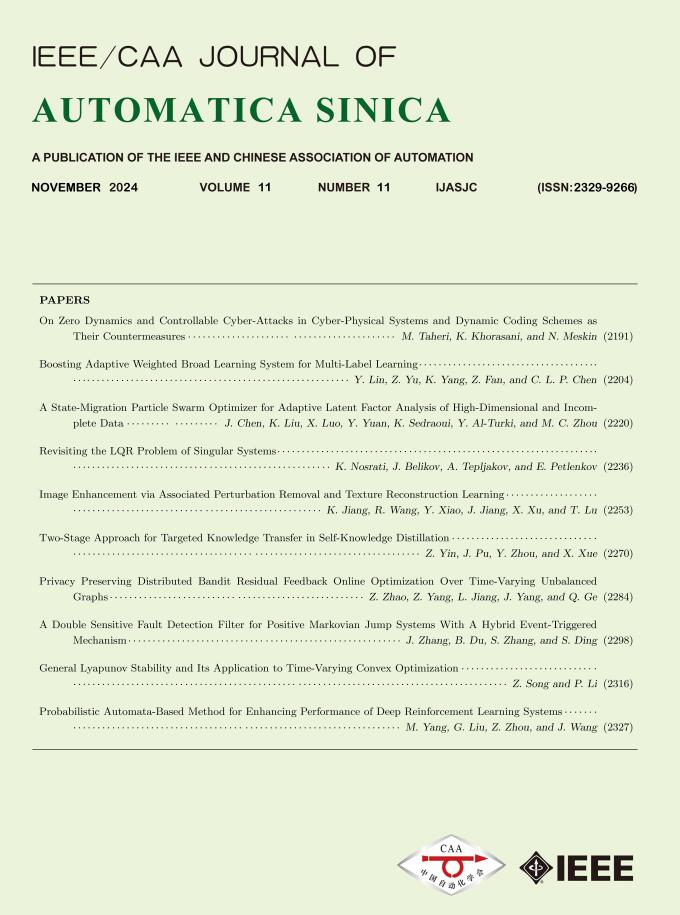 Volume 11
Issue 11
Volume 11
Issue 11
IEEE/CAA Journal of Automatica Sinica
| Citation: | Y. Liu, X. Wu, Y. Bo, J. Wang, and L. Ma, “A transfer learning framework for deep multi-agent reinforcement learning,” IEEE/CAA J. Autom. Sinica, vol. 11, no. 11, pp. 2346–2348, Nov. 2024. doi: 10.1109/JAS.2023.124173 |

| [1] |
T. Liu, B. Tian, Y. Ai, L. Li, D. Cao, and F.-Y. Wang, “Parallel reinforcement learning: A framework and case study,” IEEE/CAA J. Autom. Sinica, vol. 5, no. 4, pp. 827–835, 2018.
|
| [2] |
W. Li, X. Wang, B. Jin, D. Luo, and H. Zha, “Structured cooperative reinforcement learning with time-varying composite action space,” IEEE Trans. Pattern Analysis and Machine Intelligence, vol. 44, no. 11, pp. 8618–8634, 2022. doi: 10.1109/TPAMI.2021.3102140
|
| [3] |
R. Lowe, Y. I. Wu, A. Tamar, J. Harb, O. Pieter Abbeel, and I. Mordatch, “Multi-agent actor-critic for mixed cooperative-competitive environments,” in Proc. Advances in Neural Information Processing Systems, 2017, pp. 6832–6393.
|
| [4] |
D. Gomez, N. Quijano, and L. F. Giraldo, “Information optimization and transferable state abstractions in deep reinforcement learning,” IEEE Trans. Pattern Analysis and Machine Intelligence, vol. 45, no. 4, pp. 4782–4793, 2023.
|
| [5] |
W. Wang, T. Yang, Y. Liu, J. Hao, X. Hao, Y. Hu, Y. Chen, C. Fan, and Y. Gao, “From few to more: Large-scale dynamic multiagent curriculum learning,” in Proc. AAAI Conf. Articial Intelligence, 2020, pp. 7293–7300.
|
| [6] |
N. A. Grupen, D. D. Lee, and B. Selman, “Multi-agent curricula and emergent implicit signaling,” in Proc. Int. Conf. Autonomous Agents and Multiagent Systems, 2022, pp. 553–561.
|
| [7] |
Y. Sun, K. Zhang, and C. Sun, “Model-based transfer reinforcement learning based on graphical model representations,” IEEE Trans. Neural Networks and Learning Systems, vol. 34, no. 2, pp. 1035–1048, 2023. doi: 10.1109/TNNLS.2021.3107375
|
| [8] |
X. Gao, J. Si, and H. Huang, “Reinforcement learning control with knowledge shaping,” IEEE Trans. Neural Networks and Learning Systems, vol. 35, no. 3, pp. 3156–3167, 2023.
|
| [9] |
N. Q. Hieu, D. T. Hoang, D. Niyato, P. Wang, D. I. Kim, and C. Yuen, “Transferable deep reinforcement learning framework for autonomous vehicles with joint radar-data communications,” IEEE Trans. Communi., vol. 70, no. 8, pp. 5164–5180, 2022. doi: 10.1109/TCOMM.2022.3182034
|
| [10] |
S. Omidshafiei, D.-K. Kim, M. Liu, G. Tesauro, M. Riemer, C. Amato, M. Campbell, and J. P. How, “Learning to teach in cooperative multiagent reinforcement learning,” in Proc. AAAI Conf. Articial Intelligence, 2019, pp. 6128–6136.
|